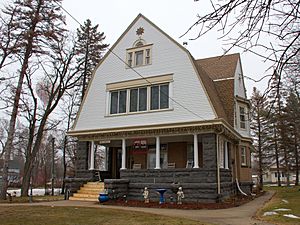Belgrade, Minnesota facts for kids
Quick facts for kids
Belgrade
|
|
|---|---|

Belgrade Centennial Museum and city water tower
|
|
| Nickname(s):
The Big Crow
|
|

Location of Belgrade
within Stearns County, Minnesota |
|
| Country | United States |
| State | Minnesota |
| County | Stearns |
| Area | |
| • Total | 1.20 sq mi (3.11 km2) |
| • Land | 1.20 sq mi (3.11 km2) |
| • Water | 0.00 sq mi (0.00 km2) |
| Elevation | 1,266 ft (386 m) |
| Population
(2020)
|
|
| • Total | 738 |
| • Density | 613.98/sq mi (237.14/km2) |
| Time zone | UTC-6 (Central (CST)) |
| • Summer (DST) | UTC-5 (CDT) |
| ZIP code |
56312
|
| Area code(s) | 320 |
| FIPS code | 27-04762 |
| GNIS feature ID | 2394108 |
Belgrade is a small city in Stearns County, Minnesota, United States. In 2020, about 738 people lived there. It is part of the larger St. Cloud area. Belgrade is famous for having the world's largest black crow statue!
Contents
History of Belgrade
Belgrade was officially started in 1887 by the Pacific Land Company. It became a village on March 19, 1888. Before that, its post office was called Crow Lake, starting in 1871. It changed to Belgrade in 1886.
When the railroad arrived in 1886, there were already many businesses in the area. The first house in Belgrade was built in 1874 by Otto Christianson, who was an immigrant from Norway.
The city was named after the first child born in the township, Isabella Theolina Christianson, in 1887. Belgrade also has a special building listed on the National Register of Historic Places. It's the Christopher Borgerding House, built in 1904. A politician and businessman named Arthur Michael Braun (1910-1989) was born in Belgrade.
When Belgrade built its Centennial Memorial park, they created the world's largest crow statue. This broke a world record!
Geography of Belgrade
Belgrade covers about 1.22 square miles (3.11 square kilometers) of land. There is no water area within the city limits.
Two important roads, U.S. Highway 71 and Minnesota State Highway 55, pass through the community. These highways help people travel to and from Belgrade.
People of Belgrade
| Historical population | |||
|---|---|---|---|
| Census | Pop. | %± | |
| 1890 | 366 | — | |
| 1900 | 450 | 23.0% | |
| 1910 | 448 | −0.4% | |
| 1920 | 487 | 8.7% | |
| 1930 | 508 | 4.3% | |
| 1940 | 553 | 8.9% | |
| 1950 | 659 | 19.2% | |
| 1960 | 666 | 1.1% | |
| 1970 | 713 | 7.1% | |
| 1980 | 805 | 12.9% | |
| 1990 | 700 | −13.0% | |
| 2000 | 750 | 7.1% | |
| 2010 | 740 | −1.3% | |
| 2020 | 738 | −0.3% | |
| U.S. Decennial Census | |||
Belgrade's Population in 2010

In 2010, there were 740 people living in Belgrade. These people lived in 312 households, and 185 of these were families.
Most people in Belgrade were White (97.0%). A small number of people were African American, Native American, or Asian. Some people were also of Hispanic or Latino background.
About 28 out of every 100 households had children under 18 living there. Many households (44.6%) were married couples. About 36.5% of all households had just one person living alone. Also, about 20.8% of households had someone aged 65 or older living by themselves.
The average age of people in Belgrade was about 42 years old. About 24.6% of residents were under 18. About 26.5% were 65 years old or older. The city had slightly more females (52.0%) than males (48.0%).
See also
 In Spanish: Belgrade (Minnesota) para niños
In Spanish: Belgrade (Minnesota) para niños

